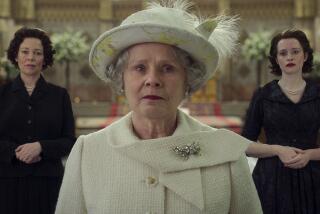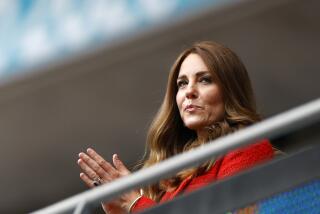Royal wedding dress is fit for a future queen
After weeks of speculation that at times verged on the absurd, Catherine Middleton emerged Friday for her wedding in a gown by Sarah Burton for Alexander McQueen. The gown is classic-looking, in silk gazar with long intricate lace sleeves, and it will probably be a force of pop culture for years to come, influencing fashion trends and reinforcing the sociological significance of the white wedding gown.
“We knew she would wear something classic, but having Sarah Burton as the designer added something modern,” said Darcy Miller, editorial director of Martha Stewart Weddings magazine. “And that’s really been the running thread with this couple — that they bring modernity to the royal family but are respectful of tradition.”
Catherine chose the British brand “for its craftsmanship and its respect for traditional workmanship and the technical construction of clothing,” according to a statement on the official wedding website. Apparently, the bride worked closely with Burton in creating the dress, which pays homage to the Arts and Crafts movement. (The timing of Catherine’s choice was auspicious. A retrospective exhibition of work by McQueen, who committed suicide last year, is set to open Wednesday at the Metropolitan Museum of Art in New York. Burton was named as his successor in May 2010.)
Photo gallery: The royal wedding
The lace applique for the gown’s bodice and skirt was handmade by the Royal School of Needlework, based at Hampton Court Palace. Individual flowers were hand-cut from lace and sewn onto ivory silk tulle to create an organic design with rose, thistle, daffodil and shamrock motifs.
The skirt is meant to echo an opening flower, and the bodice to draw on the Victorian tradition of corsetry. The train is just short of 9 feet. French Chantilly lace was combined with English Cluny lace in the Carrickmacross needlework tradition that originated in Ireland in the 1820s. The needleworkers washed their hands every 30 minutes to keep the lace and threads pristine, and the needles were replaced every three hours to keep them sharp and clean.
Royal wedding photos
The ceremony | The dress | The hats | The cars
“The royal wedding legitimizes luxury and reinforces the princess myth,” said Cele Otnes, a marketing and advertising scholar at the University of Illinois at Urbana-Champaign, and co-author of the book “Cinderella Dreams: the Allure of the Lavish Wedding.” “We get to have a piece of that myth, whether we consume it vicariously by watching it on TV, getting a knockoff gown or modeling our wedding after it.”
The long-sleeved gown, which Catherine accessorized with a 1936 Cartier tiara borrowed from Queen Elizabeth, “will be a major shift in fashion. There are thousands of girls who will want to step into that fantasy,” said Don O’Neill, creative director of evening and bridal wear label Theia, who created a $2,495 “Kate” gown with illusion lace sleeves before he even saw the big reveal on Friday.
JS Collections, another eveningwear label, expects to have a replica of the royal gown available for pre-order early next week. David’s Bridal plans to have a prototype of the dress shortly, as does the dress label Faviana.
When it comes to fashion, royal weddings have always been influential.
Queen Victoria broke with the custom of wearing coronation robes and chose a white gown when she wed in 1840.
In 1960, Princess Margaret’s sleek, Norman Hartnell-designed wedding gown was a precursor to more modern-looking styles. And Princess Diana’s poufy, romantic David and Elizabeth Emanuel gown reverberated through the fashion of the 1980s with the flamboyant, neo-romantic designs of Vivienne Westwood, Christian Lacroix and others.
But the iconic white wedding dress was really a creation of the 20th century.
Before that, weddings were typically arranged, and women married in the best dress from their closets. Around World War II, clothing manufacturers saw an opportunity to establish a bridal wear market, said Cynthia Amneus, a curator of costume and textiles at the Cincinnati Art Museum and author of the 2010 book “Wedded Perfection: Two Centuries of Wedding Dresses.” “They actually went to Congress to lobby to have war restrictions on fabrics eased for bridal dresses. They framed it as, ‘This is what our boys are fighting for, to come home and marry their sweethearts.’”
With that, the modern bridal industry was born, bridal magazines became popular, and the descriptions of brides began to change from “virginal” and “sweet” to “fairy princess” and “regal.”
Postwar bridal designers began to romanticize historical dress styles. In the 1950s, women were enchanted by the weddings of Jacqueline Bouvier and Grace Kelly. Bridal gowns followed the fashions of the times, with nipped waists and full skirts reflecting the feminine, happy-homemaker ideal that had become synonymous with the American dream.
In the 1960s and ‘70s, as women’s roles began to shift with the emerging feminist movement, bridal styles were equally transformed. A variety of choices was available, from Empire-waist gowns to chain mail mini-dresses.
“Today, when a woman decides to get married, she’s stepping into a marriage willingly, she’s financially independent, educated and pretty much knows what she’s getting into. The dress is an expression of her self,” Amneus said. “But in any age, women of lower economic status look up to monarchs and aristocrats to see what they are wearing and dream about what they have.”
Photo gallery: The royal wedding
Photo gallery: The royal wedding dress
Times staff writer Deborah Netburn contributed to this report.
More to Read
Sign up for Essential California
The most important California stories and recommendations in your inbox every morning.
You may occasionally receive promotional content from the Los Angeles Times.











